[Originally published as The Gambler’s Faith]
Concerning mutation, what drives this process? What can we observe?
Evolution can be ascribed by the mainstream to a range of circumstances, including genetic drift or natural selection, but by far the most common mechanism relied upon for the process is mutation.
It is, for the naturalist, the quintessential engine that drives the evolution process, pushing simple cells towards great majestic beasts, and ultimately us.
Mutation is critical to their worldview, to say the least.
A Basic Definition
At its core, mutation is nothing but a change in sequence of the DNA of an organism. Such changes can include a loss of base pairs – even whole genes – or alternatively an inclusion of a few new nucleotides in a sequence. Sometimes it is as simple as a single nucleotide being swapped with another, an adenine-thymine base pair being replaced instead with a cytosine-guanine pair. In all cases, whether minor or catastrophic, the DNA is tangibly altered, yet the degree to which the alteration impacts the life form is itself dependent on a number of variables.
The Power of Mutations
In action, mutation can certainly drive massive changes in a life form’s physiology. That isn’t debatable. What is debatable is the benefit of such changes.
For successful evolution to occur, the mutations that drive one kind of life to another (if such a thing where even possible) would have to present some significant breakthroughs in terms of biological application.
Consider the supposed transition of fish into amphibians. At some point, the aquatic fish would have had to develop structures and behaviors that were compatible with a drive to leave the water. As we have already demonstrated with the nature of DNA, the genes they construct, and the cells that make up the basis of biology, life is staggeringly complex, and to suggest that a simple mutation – or even a successive suite of mutations – would be enough drive a magnificent transition from one form of life into a completely new form is beyond rationalization in my mind, especially when we consider the chaotic, random nature of mutation in general.
There exists a statistical phenomenon referred to by mathematicians as
“The Gambler’s Ruin.”
While several similar models are associated with the title, all share a common theme, in which, a gambler with finite wealth, in a fair game, will always lose to an opponent with an infinite amount of wealth. The phenomenon holds true in many areas and is especially true here, applied critically to mutation.
Bear with me for a moment…
Mutation, being random, is inherently a gamble. It is a biological bet, requiring life – which is irrevocably bound to the mutation without any choice in the matter – to accept whatever the outcome may be, good or bad, beneficial or deadly.
Assuming that the change does not directly prove lethal to a parent carrying it, then there is a great possibility that the mutation will be passed down to its offspring. As time progresses, these cumulative mutations are found throughout the genome, detrimentally degrading the once purer genome into that with which we are accustomed to today.
How many mutations does it take to destroy a genome? How many shifts from the functional original to the contemporary patchwork can be allowed and yet remain viable, vibrant and biologically feasible? This accumulation phenomenon is known as “genetic load,” and can be seen in a range of organisms, including man, and it stands as a testament that mutation is not a drive for progressive evolution, but rather degradation.
Mutations are, by all accounts, in essentially every case known and documented, either neutral or harmful to the possessing life form, and never have been known to add viable genetic information in any evolutionary sense. All instead appear to decrease in overall genetic complexity and integrity.
While secular sources will point to antibiotic-resistant bacteria or sickle-cell anemia as beneficial mutations, the truth is that, though an obvious benefit may can be seen from one perspective, in fact each of these – and a myriad others – reflect a loss-of-information mutation, whereby the physiology of the life form is altered via a mutation which warped or deleted its natural genes.
Outside the context of our antibiotic treatments or instances of malaria, such “evolutionary advancements” are either unnoticed by the organism, or otherwise accompanied by serious, sometimes deadly, effects. Antibiotic-resistant bacteria, for instance, typically have less survivability than wild-type bacteria of the same strain once the antibiotics have been removed from their environment, and likewise sufferers of sickle cell anemia experience a lifetime of gnawing and throbbing pain as the burden of their immunity to malaria.
Purpose and Function
Still again, for the evolutionist, how can the blind actions of unthinking molecules accumulate into superbly complex synergies of form and function, advancing one organism well beyond its former boundaries, or bring disparate organisms together in mutual benefit, or most strikingly, replicate the features and behaviors of one life form within the body of a completely unrelated form in an effort to promote defense or reproduction?
Does it not seem ludicrous to accept such, to believe that the mistakes of molecules, each depending on a level of perfection far more tedious than what man is accustomed too, can construct such feats through chaos? What of the systems that require sophistication from the onset, e.g. echolocation and others?
Nature, any biologist will confirm, is most often conservative, retiring unused organs and systems, so no explanation advocating a gradual development of the eye, or ears, or any number of specialized features is acceptable in this light, whereby their components are useless wastes of biomaterials until the fullness of the system’s portions have been assembled, hardware and software together.
For mutation to have such power, to be capable of so completely and fundamentally shaping life, it has to be either magical or directed. There is no alternative – no naturalistic explanation – that broaches the facts of the matter.
Real World Mutations
Mutation is undeniable in biology, a condition of our existence, and their effects are profound in their contribution to the survivability of life. That it produces new arrangements of nucleotides is not in question, but yet, do these new arrangements equal actual information, or is it just happenstance that occasionally a new pattern of base pairs falls into just the proper order to cancel some long-standing gene for the production of a particular enzyme, thereby making the bacterium resistant to a drug?
Can a faulty bet often lead to success? Although the chances are infinitesimally slim, it does happen, and a risk can lead to a windfall; yet as in the casino, such lucky gambles are rare and dangerous affairs. In biology, accidents can lead to a situational benefit, but far more often than not, the results are detrimental to the wellbeing of the mutated.
The Observer’s Assumptions
If pure naturalism is all that has been at play in the rise of life, then why has “The Gambler’s Ruin” not been statistically fulfilled? How has the gambler persisted in spite of finite resources? Put another way, how has life persisted unaided in the face of untold generations of accumulated mutational burdens on their genes, with the evidence indicating an infinitely more common occurrence of useless or even deadly mutations instead of beneficial ones?
Shouldn’t life have genetically bankrupted like the unlucky gambler long ago if we were on our own?
Looking across nature, we should never cease to be staggered by the complex diversity in existence. The five kingdoms of life, each rich with endless forms, should continuously lead our minds to wonder. Of these, more successful, more special than any other form of life, is us…
…
– This was an excerpt from the book “Remnants of Eden: Evolution, Deep-Time, & the Antediluvian World.”







